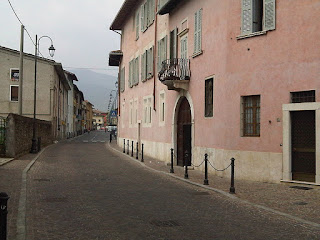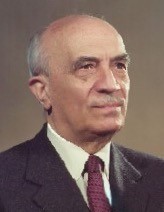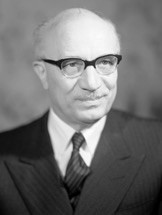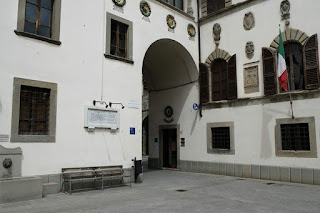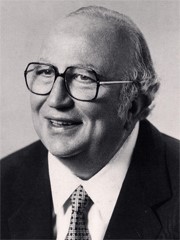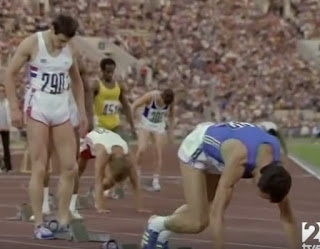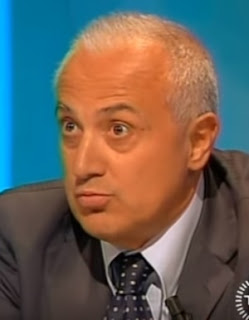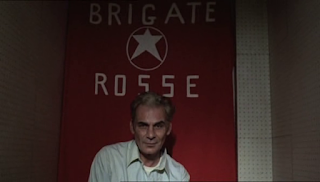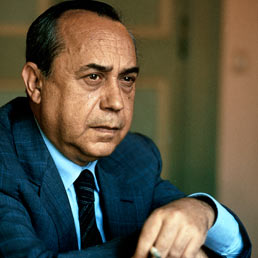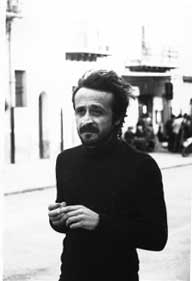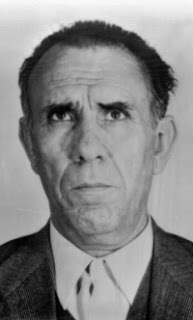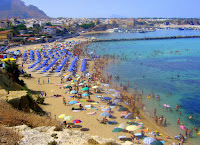Christian Democrat spent 45 years in government
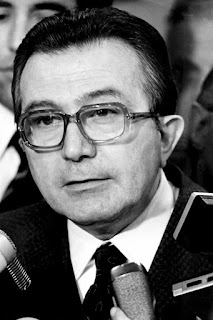 |
| Giulio Andreotti, pictured in 1979 |
Giulio Andreotti, who was Italy's most powerful politician for a period lasting almost half a century, was born on this day in 1919 in Rome. He was a member of almost every Italian government from 1947 until 1992, leading seven of them.
He would have certainly gone on to be president were it not for the scandals in which he became embroiled in the 1990s, when his
Christian Democrat party collapsed as a result of the
mani pulite - clean hands - bribery investigations. Andreotti himself was accused of an historic association with the Mafia and of commissioning the murder of a journalist, although he was acquitted of the latter charge on appeal.
The youngest of three children, Andreotti was brought up in difficult circumstances by his mother after his father, who had taught at a junior school in
Segni, about 60km (37 miles) south-east of the capital in Lazio, had died when he was only two years old.
In contrast with the unassuming, mild-mannered persona for which he became known as an adult, the young Andreotti had a fiery temper. On one occasion, in church, he attacked another altar boy, stubbing out a lit taper in his eye after feeling he had been ridiculed.
He attended the prestigious
Liceo Torquato Tasso in Via Sicilia, not far from the Borghese Gardens and the Via Vittorio Veneto, before going on to graduate with honours after studying law at the
University of Rome, while at the same time working in a tax office.
An opponent of
Fascism, Andreotti's instinct was to keep his head down during
Mussolini's reign but he did join the Italian Catholic Federation of University Students (FUCI), which was the only non-fascist youth organisation allowed to exist at the time. Membership of the group enabled him to meet
Aldo Moro, the future Christian Democrat prime minister, whom he succeeded as FUCI president in 1942.
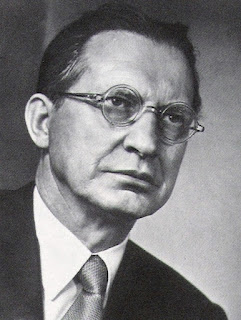 |
Alcide de Gasperi, the founder of the
Christian Democrats and Andreotti's sponsor |
Italy voted to become a republic in 1946 and Andreotti's political career began at the same time. With the support of the first prime minister of the republic,
Alcide de Gasperi, he was elected to the Constituent Assembly, the provisional parliament which had the task of writing the new Italian constitution.
De Gasperi had been a fierce opponent of Mussolini and was imprisoned in 1927 before being released on the grounds of poor health and being given refuge by the Catholic Church. He met Andreotti at the
Vatican Library, where he worked as a cataloguer between 1929 and 1943. The latter showed enthusiasm for the Christian Democrat party De Gasperi had been secretly establishing and when the party was formally launched it was not long before Andreotti was appointed as De Gasperi's assistant.
Andreotti began his government career in 1947, when he became Secretary of the Council of Ministers in De Gasperi's cabinet at the age of just 28. The following year he was elected to the newly formed Chamber of Deputies, representing the constituency of
Rome-Latina-Viterbo-Frosinone, which would remain his stronghold until the 1990s.
During Andreotti's long period of influence, there were many groups with a vested interest in making sure that the country was run by a Catholic party, and it was Andreotti's ability to form unlikely alliances across the country's fragmented political spectrum that held the line for so many years.
Those groups included, naturally enough, the church itself - still a massive part of the fabric of Italian society. The
United States, meanwhile, was determined to keep Italy out of the hands of the Italian Communist Party, which also suited the drivers of Italy's post-War industrial and financial recovery. The Mafia, too, feared that their ability to strike clandestine deals would be compromised by a shift to the left. Andreotti, a quiet, self-effacing man who carried an aura of calm, emerged as the perfect figure to stand untouched at the centre of the whirlwind of Italian political life, skilfully maintaining the status quo.
In that Italy did not become communist and grew at one point to be the fifth largest economy in the world, he succeeded. But his time at the forefront was not without difficult moments, most notably the kidnap and murder of his friend,
Aldo Moro, by the
Red Brigades in 1978.
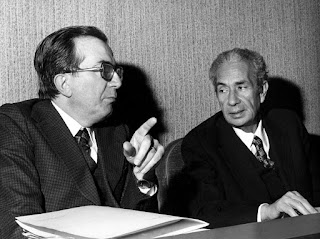 |
Andreotti, left, with Aldo Moro in 1978, shortly before the
latter was kidnapped by the Red Brigades terrorist group |
Andreotti refused to negotiate with the terrorist group, despite personal pleas from Moro, while the police and Italian secret services attracted criticism for failing to locate the apartment in which the former prime minister was being held, even though it was under their noses in central Rome.
Theories began to circulate that Andreotti was somehow complicit in the kidnap because Moro had been one of the politicians pushing for the so-called
'historic compromise', in which the Communists would be invited to play a direct role in government for the first time, in return for keeping the Christian Democrats in power.
Nothing was ever proved, although what is fact is that, after Moro had been killed, Andreotti took the opportunity to propose a government of 'National Solidarity' in the face of the possibility of more acts of terrorism, strengthening his grip on power. The Communists supported the move but when they asked to participate directly in a new coalition, they found the 'historic compromise' was no longer on the agenda.
The theories resurfaced in the 1990s when Andreotti admitted the existence at the time of the kidnap of
Operation Gladio, an undercover network sponsored by NATO and the US secret services to bolster Italy as the last line of defence against the advance of Soviet communism.
Similar theories lay behind the accusation that Andreotti had colluded with the Sicilian Mafia to arrange the murder of a journalist,
Carmine Pecorelli, in Rome in 1979, to prevent the publication of a book by Pecorelli which contained information related to the Moro kidnap that would probably have ended Andreotti's career.
In 2002, Andreotti was sentenced, along with Mafia boss
Gaetano Badalamenti, to 24 years in jail for Pecorelli's murder. The sentence was thrown out by the Italian Supreme Court in 2003.
A long-running investigation into Andreotti's suspected links with the Mafia ended with no sentence handed down after a court in Palermo decided that, since no links could be proved after 1980, too much time had elapsed for Andreotti to be prosecuted.
The disbanding of the Christian Democrats after the
mani pulite revelations did not spell the end of Andreotti, although his role in politics became increasingly peripheral. He died in Rome in 2013 at the age of 94.
 |
The Palazzo Chigi in Rome is the official residence
of the Italian prime minister |
Travel tip:
During the six and a half years in total that Giulio Andreotti was Italy's prime minister, his official residence was the
Palazzo Chigi in Piazza Colonna, a square just off Via del Corso, about equidistant from the Trevi Fountain and the Pantheon. Originally built in 1580 for the Aldobrandi family - Ippolito Aldobrandi was Pope Clement VIII - it was bought by the Chigi family in 1659. In 1878 it was acquired by the Austro-Hungarian empire to be the residence of their ambassador in Rome before the Italian state took ownership in 1916.
Travel tip:
First-time visitors to
Rome might be daunted by the prospect of so much to see in such a large area and not know where to start. In fact, most of the city's major attractions and contained within a four sided area that can be defined on a map by drawing a line between the Vatican and the Borghese Gardens, Stazione Termini, the Baths of Caracalla and back to the Vatican. Even so, it would take the best part of a week to see everything contained within that area.
More reading:
Alcide de Gasperi - the prime minister who rebuilt Italy
The kidnap and murder of Aldo Moro
Enrico Berlinguer - the leader who turned Italy's Communists into a political force
Also on this day:
1883: Birth of fashion designer Nina Ricci
(Picture credit: Palazzo Chigi by Jordiferrer via Wikimedia Commons)
Home


